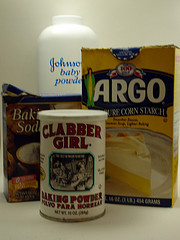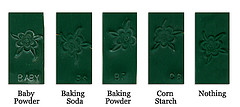Comparing Different Powders as Rubber Stamp Resists
 Saturday's lesson at my guild went well. We had a big group, & I think everyone enjoyed making coasters.
Saturday's lesson at my guild went well. We had a big group, & I think everyone enjoyed making coasters.
One question came up that I wasn't prepared for, though. I was talking about the different types of "resists" (also called release agents) you can use to keep your rubber stamp from sticking to polymer clay when you're stamping without ink. A spritz of water is one option, though it doesn't work for all clays (specifically, UltraLight Sculpey gets sticky when wet). Another option is dusting the sheet of clay with powder (such as baby powder, corn starch, or baking soda) before stamping.
As I was going over these options one of my guild members asked, "How do you keep the powder from filling in the grooves?" Apparently when she'd tried this in the past, the powdery bits had gotten stuck in the impressions of her stamped clay. I asked which type of powder she was using, thinking some powders might work better than others. But when she answered, I realized I didn't know what I was using!
See, I've had the same little baggie of white powder sitting on my craft desk for years. I poured a bunch of something into it a long time ago, and just haven't needed to refill it. And in the meantime, I've forgotten what I used. As an aside, this makes me slightly uncomfortable every time I drive to guild. What if a highway patrolman pulled me over? How would it look to have a little baggie full of white powdery stuff, especially if I couldn't readily identify what it was? I always drive especially carefully on guild days. :-)
Anyway, after I got home, I did a taste test to see what I'm actually using. (I don't recommend this, by the way. Baby powder and baking soda do NOT taste yummy.) Turns out my baggie's filled with corn starch.
The Test
I ran a few tests using some other powders to see if corn starch is in fact the best one to use. I used the same stamp to stamp into 5 sheets of unbaked clay, each of which had one of the following sprinkled on top: Baby Powder, Baking Soda, Baking Powder, Corn Starch, and Nothing
 In each case I sprinkled the powder on fairly liberally, but rubbed almost all of it off before stamping. All that was left was a faint powdery residue. All of the powders resisted the stamp just fine (no sticking). After stamping, I used a paper towel wet with rubbing alcohol to dab off the excess powder before baking. Here are my results for each powder:
In each case I sprinkled the powder on fairly liberally, but rubbed almost all of it off before stamping. All that was left was a faint powdery residue. All of the powders resisted the stamp just fine (no sticking). After stamping, I used a paper towel wet with rubbing alcohol to dab off the excess powder before baking. Here are my results for each powder:
- Baby Powder: The baby powder did not readily dissolve or wipe away. Instead it seemed to rub into the clay. It also brushed into the grooves and lodged itself there.
- Baking Soda and Baking Powder: These two are both a little more gritty than the other options, meaning you may find yourself adding a little unintentional texture if you use them. But they did dissolve readily.
- Corn Starch: It has a nice (non-gritty) texture. It dissolved pretty well, although I could see some evidence of it in the impressions after baking.
- Nothing: This particular test used a very small stamp without a lot of intricate parts, so it didn't stick to the clay enough to actually need a release. In this case, using nothing would be an option, but you'll often find you need something for larger stamps or sticky clay.
The winner? They all have their pros and cons, but corn starch is still my favorite, primarily because I don't like the grainy texture of the baking powder or soda. Baby powder was my least favorite. Of course, if you're antiquing the clay after baking, you may not mind a little powder residue. In that case any of the options are fine. If, however, you really need a clean, un-powdery impression, a water resist is probably your best bet.
Tips for Success
- Powder Lightly: My main tip is to keep the powder coating very light. If there's not a lot of extra powder there, it's less likely to build up in the grooves.
- Get Rid of the Excess: Wiping the excess off before baking is optional. Sanding it off afterwards works just as well (and may be necessary anyway).
- Clean out the Grooves: If you do get some powder in the grooves, try soaking it, then digging out any embedded stuff with a needle tool. Rubbing alcohol on a Q-tip may also do the trick
Thanks to the guild for making my Saturday an enjoyable one and for asking questions that made me think. I'm happy to say that, I can now look that highway patrolman straight in the eye and say, "It's corn starch, sir."

